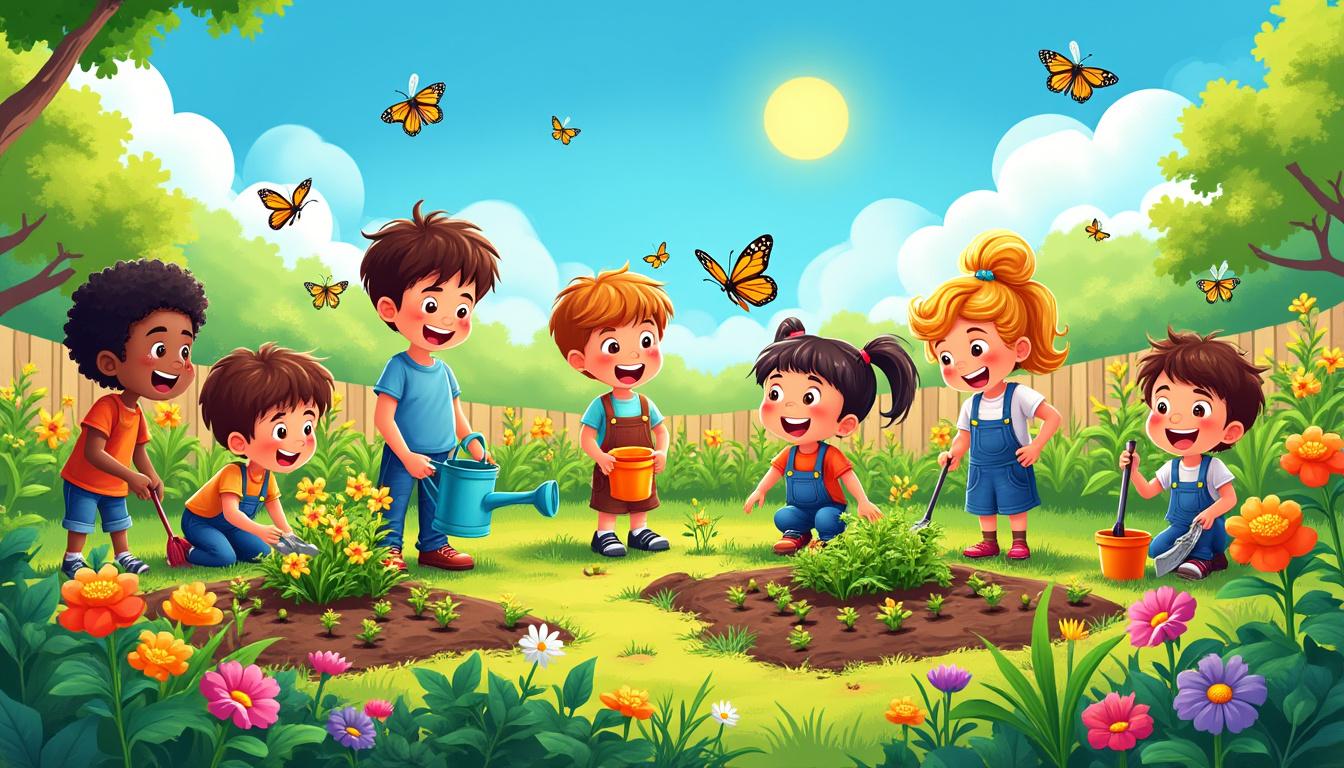In a world increasingly dominated by screens and indoor activities, encouraging children to cultivate their own garden emerges as a vital pathway to reconnecting with nature and fostering a lasting passion for gardening. Gardening offers more than just a hobby—it nurtures responsibility, creativity, patience, and a stronger connection to the environment. The process of planting seeds, observing growth, and eventually harvesting produce connects children to natural cycles and empowers them with a gratifying sense of accomplishment. This article explores diverse strategies and insights aimed at inspiring young gardeners, enriching their experience, and helping parents and educators create supportive, engaging environments where kids can thrive alongside their plants.
How To Empower Kids With Ownership In Their Kid’s Garden Projects
One of the most effective ways to inspire a deep love for gardening in children is by granting them genuine ownership over their gardening space. Unlike adult-directed gardens, a child’s plot thrives when it reflects their personal choices and creativity. Starting with a visit to a local nursery or garden center like The Home Depot or Burpee, children should be encouraged to select plants that interest them personally. This could range from vibrant annuals like sunflowers and marigolds to easy-to-grow vegetables such as cherry tomatoes or radishes. By allowing kids to select plants they are excited to grow and eventually eat, gardening becomes a meaningful and motivating experience.
Choosing plants that are safe and suitable to the local environment is vital. For example, plants with toxic parts, such as rhubarb leaves, should be avoided unless supervised closely. Resources like the national Poison Control center provide guidance on plant safety, emphasizing the importance of a secure gardening environment for children.
After plant selection, it’s essential to involve kids in designing their garden plot. Using tools ranging from child-size rakes and spades from Gardener’s Supply Company to simple yardsticks, children can measure, plot, and even name their garden beds or containers. Naming plants and designating garden areas with personalized signs—such as “Lily’s Sunflower Patch” or “Ethan’s Carrots”—fosters emotional investment. This personal connection encourages kids to protect and care for their green spaces actively.
- Take children to nurseries and let them pick plants.
- Choose child-friendly, non-toxic plants that suit the local climate.
- Provide child-sized gardening tools and gloves.
- Allow children to measure and map their garden space.
- Encourage naming the garden and individual plants.
| Plant Type | Suitability for Kids | Growing Requirements | Safety Notes |
|---|---|---|---|
| Sunflowers | Excellent – fast growth and colorful | Full sun, moderate watering | Non-toxic |
| Cherry Tomatoes | Good – edible and fun to grow | Full sun, well-drained soil | Monitor for toxicity of leaves/stems |
| Marigolds | Good – easy to maintain and vibrant blooms | Full sun to partial shade | Non-toxic |
| Radishes | Excellent – quick harvest | Cooler weather, loose soil | Non-toxic |
| Rhubarb | Not recommended for unsupervised kids | Cool climate, well-drained soil | Toxic leaves, avoid ingestion |
To further engage kids, considering modular garden solutions such as the Garden Tower Project offers exciting vertical gardening options that save space and allow for fun, hands-on interaction with plants. Combining such setups with creative themes from companies like Sprout House or Green Kid Crafts provides enriching, educationally focused gardening experiences tailored for children.
Teaching Gardening Skills That Build Responsibility And Joy
Farm-to-table concepts are increasingly popular in educational settings, highlighting how gardening can teach crucial life skills like patience, responsibility, and observation. Kids learn that gardens require not only planting but consistent care, including watering, weeding, and monitoring for signs of hunger or disease. Utilizing kid-friendly tools and incorporating calendars or charts enhances their understanding of garden maintenance while giving them a sense of accountability.
For example, a calendar placed in a child’s bedroom or kitchen serves as a daily reminder and motivator to water their plants or remove weeds. Crossing off completed tasks fosters a sense of accomplishment. Studies confirm that children involved in such routines develop stronger organizational skills and self-discipline.
Teaching plants’ nutritional needs helps kids grasp the basics of ecology and biology. Explaining how plants “eat” through soil nutrients and “drink” via water engages their curiosity. When plants show signs of distress, children can be guided to adjust care routines—perhaps increasing watering or adding natural fertilizer. This interactive problem-solving sharpens critical thinking.
- Use watering schedules or chore charts to encourage responsibility.
- Introduce basic plant nutrition concepts to foster understanding.
- Demonstrate how to recognize garden stress signs.
- Allow children to experiment and learn from mistakes.
- Celebrate milestones, such as first bloom or harvest.
| Caring Task | Frequency | Child-Friendly Tips | Benefits for Kids |
|---|---|---|---|
| Watering | Daily to twice a week depending on weather | Use lightweight watering cans, tie task to a calendar | Teaches routine and observation |
| Weeding | Weekly | Use small hoes or fingers, make it a game | Develops focus and patience |
| Fertilizing | Monthly or bi-monthly | Use organic or kid-safe fertilizers, teach plant needs | Builds understanding of plant biology |
| Harvesting | When plants mature | Show maturity signs; compare ripe vs unripe | Enhances decision-making and patience |
Incorporating Technology And Innovative Gardening Tools For Engaged Learning
Modern gardening tools and platforms are revolutionizing how children engage with gardens. Brands like Gardena and Kid’s Garden offer intuitive, child-sized equipment designed to boost safety and fun during gardening activities. Smart garden kits and apps enable kids to monitor moisture levels, sunlight exposure, and plant health digitally.
Integrating technology with hands-on gardening makes the learning experience dynamic and tailored. For example, the Sprout House interactive kits and Green Kid Crafts provide subscription boxes containing projects that combine science, art, and gardening. These tools encourage children to experiment, craft, and build their garden ecosystems, increasing engagement.
Additionally, platforms featuring virtual garden planners or augmented reality overlays allow kids to visualize garden layouts and track progress, nurturing organizational skills and foresight. These innovative approaches blend digital literacy with environmental stewardship.
- Use kid-friendly, ergonomic gardening tools from trusted brands.
- Introduce smart gardening devices to track conditions.
- Subscribe to educational boxes blending crafts and gardening.
- Employ apps and virtual planners for garden design.
- Encourage creative construction of garden elements, like compost bins or pollinator habitats.
These technology-driven methods complement traditional gardening practices, making the experience rich and relevant in today’s digital era. Engaged children are more likely to cultivate a lifelong passion and understanding of ecological responsibility through such hybrid approaches.
Seasonal Gardening Tips To Maintain A Year-Round Kid-Friendly Garden
Gardening is a cycle that offers unique lessons and pleasures throughout the year. Enabling children to observe seasonal transformations keeps their interest alive and educates them about plant lifecycles and climate effects. For instance, late summer gardening involves strategies to prepare plants for cooler months and maximize harvests, while winter gardening can introduce hardy plants and indoor gardening practices.
Companies like Garden Tower Project provide innovative solutions for urban or small spaces, enabling winter gardening in containers or tower gardens. These approaches are ideal for keeping kids connected to gardening even in colder months or restricted outdoor areas. Resources such as winter gardening tips and late summer gardening guides offer practical advice to nurturing gardens year-round.
- Teach children about seasonal changes and plant dormancy.
- Explore indoor gardening during colder months.
- Use adaptable container gardens to maximize space.
- Involve kids in prepping soil and tools for spring.
- Harvest and preserve foods like herbs or seeds.
| Season | Kid-Friendly Gardening Activities | Gardening Focus | Example Plants |
|---|---|---|---|
| Spring | Seed starting, planting flowers | Growth and renewal | Sunflowers, lettuce, pansies |
| Summer | Watering, weeding, harvesting fruits | Maintenance and care | Tomatoes, beans, marigolds |
| Fall | Composting, preparing beds | Transition and preservation | Carrots, herbs, kale |
| Winter | Indoor gardening, planning | Rest and preparation | Herbs, microgreens, bulbs |
By guiding children through the natural, cyclical nature of gardening, parents can cultivate not only plants but also resilience and respect for the environment. These values support more sustainable living and an enriched relationship with nature, pivotal in educational gardening contexts too.
Building Community And Social Connections Through Kid’s Gardens
Gardening projects can become powerful community-building tools when shared among neighbors, schools, and social groups. Organizations like Nature’s Classroom and Little Green Fingers promote outdoor learning and community engagement through garden programs designed for children. These initiatives encourage teamwork, social skills, and environmental awareness while celebrating nature’s bounty.
Community gardens designed for kids offer shared spaces where children learn from each other, exchange plant seedlings, and participate in garden-focused events and workshops. This social aspect can motivate reluctant young gardeners by adding an element of fun and peer bonding.
Creating forums or club groups connected to vendors like Gardener’s Supply Company or The Home Depot might also facilitate access to gardening resources, tips, and rewards for consistent gardening achievements, further enhancing commitment and enthusiasm.
- Participate in local or school gardening clubs.
- Exchange seeds and gardening tips with peers.
- Host garden-themed events and challenges.
- Engage with community organizations supporting kids’ gardening.
- Utilize resources from trusted gardening suppliers.
| Community Garden Benefits | Examples | Outcomes For Kids |
|---|---|---|
| Social Skills Development | School garden clubs, neighborhood projects | Improved communication and teamwork |
| Environmental Education | Workshops from Nature’s Classroom | Greater awareness and respect for nature |
| Sustainable Habits | Composting programs, recycling efforts | Long-term eco-conscious lifestyles |
Fostering community gardens also helps combat the isolation growing in an urbanized, digital era. Kids not only gain gardening knowledge but also form lasting friendships and a sense of belonging, enriching their emotional and social development holistically. Such environments encourage ongoing participation and a lifelong passion for the natural world.
Frequently Asked Questions About Encouraging Kids In Gardening
- What are some easy plants for kids to start with in their garden?
Plants like radishes, marigolds, cherry tomatoes, and sunflowers are excellent starting points due to their hardiness and rewarding growth cycles. - How can parents safely introduce gardening to young children?
Use non-toxic plants, child-sized tools from brands like Gardener’s Supply Company, and supervise activities closely while encouraging exploration. - What role does technology play in modern gardening for kids?
Smart gardening tools and educational subscription boxes integrate technology to enhance engagement and provide interactive learning opportunities. - How can gardening teach responsibility in children?
Assigning daily or weekly tasks like watering and weeding develops routine, planning skills, and accountability. - Where can families find resources and support for kid-friendly gardening?
Resources like the Garden Tower Project, Sprout House, and Green Kid Crafts provide educational products, while community organizations such as Nature’s Classroom offer programs and workshops.

